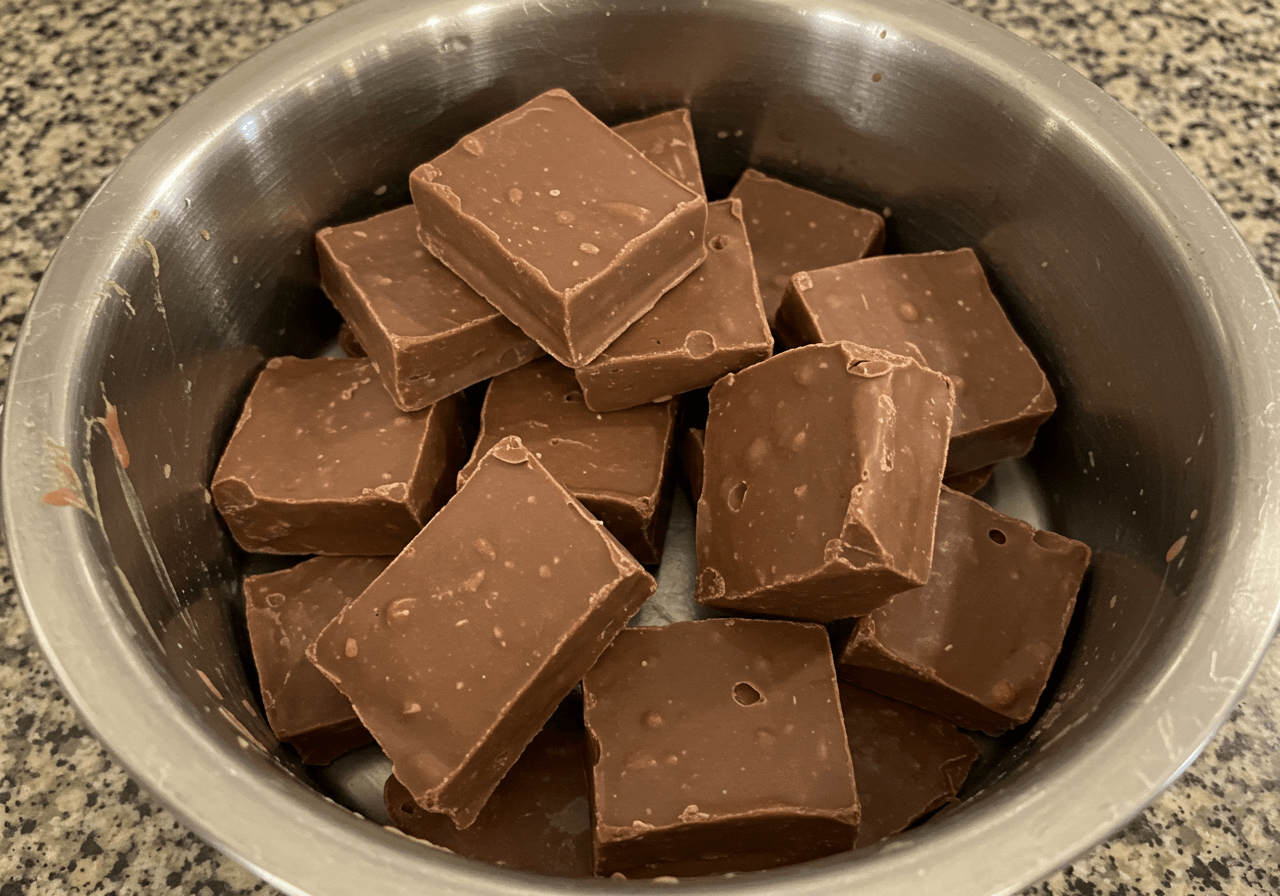Alright, let’s get one thing straight—good fudge isn’t just candy; it’s a mood. Whether you’re making it for the holidays, gifting it to friends, or sneaking a square after dinner, soft fudge is pure comfort. But if you’ve ever tried to make fudge at home, you know it’s not always smooth sailing. Sometimes it turns grainy, too hard, or—worst of all—refuses to set.
So, what’s the secret to that perfect, soft, creamy fudge texture? Don’t worry, I’ve got you covered. In this post, we’ll talk about everything from ingredient choices to cooking techniques, and I’ll even throw in a few pro tips and FAQs to make sure your next batch of fudge is chef’s kiss perfect.
Grab your candy thermometer, and let’s make some fudge magic happen!
Table of contents
- 🛒 Ingredients You Need for Soft Fudge
- 👩🍳 Step-by-Step Instructions for Perfect Soft Fudge
- 🧠 Why Does Fudge Turn Out Hard or Grainy?
- 🕒 Cooking Tips for Soft and Creamy Fudge
- 🍬 The Science Behind Soft Fudge
- 🍪 Variations to Try with Soft Fudge
- 🍯 The Role of Sugar in Soft Fudge Texture
- 🍶 Why Butter and Dairy Matter in Soft Fudge
- 🥣 The Art of Stirring: Timing Is Everything
- 🍫 Choosing the Right Chocolate for Soft Fudge
- 🌡️ Temperature: The Make-or-Break Factor for Soft Fudge
- 🥄 Common Mistakes When Making Soft Fudge (and How to Avoid Them)
- 🧊 How Humidity Affects Fudge Texture
- 🍬 Soft Fudge as a Gift: Tips for Perfect Presentation
- 🥥 Fun Add-Ins for Soft Fudge
- 🧠 Understanding the Cooling Process for Fudge Perfection
- 🍂 Why Soft Fudge Is a Timeless Treat
- ❓ Frequently Asked Questions (FAQs)
- 🥄 Fudge Troubleshooting Table
- 🧊 Storing and Freezing Fudge
- 💬 Final Thoughts: Mastering the Secret to Soft Fudge
🛒 Ingredients You Need for Soft Fudge
Before diving into the details, let’s talk ingredients. Good fudge starts with quality ingredients, and yes—every choice matters.
| Ingredient | Purpose | Tips |
|---|---|---|
| Sugar | Sweetness & structure | Use granulated sugar |
| Butter | Richness & smoothness | Real butter, unsalted |
| Condensed Milk | Creaminess | Sweetened, not evaporated |
| Chocolate | Flavor & texture | High-quality chocolate |
| Vanilla Extract | Enhanced flavor | Pure vanilla, not artificial |
| Corn Syrup | Prevents crystallization | Optional, but helpful |
| Salt | Balances sweetness | Just a pinch |
Pro Tip: Avoid reducing sugar—it’s not just for sweetness; it’s crucial for texture.
👩🍳 Step-by-Step Instructions for Perfect Soft Fudge
Step 1: Prep Your Tools
- Use a heavy-bottomed saucepan to prevent burning.
- Have a candy thermometer ready. Trust me, it’s your best friend here.
- Line your pan with parchment paper for easy removal.
Step 2: Cook Your Sugar Mixture
- Combine sugar, butter, and condensed milk in your saucepan.
- Heat over medium heat, stirring constantly.
- Bring to soft ball stage (about 234°F to 240°F) on your thermometer.
Why This Matters: The soft ball stage determines the fudge’s texture. Too hot = crumbly fudge. Too cool = gooey mess.
Step 3: Add Chocolate and Flavoring
- Remove from heat and stir in chocolate and vanilla extract until smooth.
- Keep stirring—it’s an arm workout, but worth it.
Step 4: Pour and Set
- Pour the mixture into your lined pan.
- Smooth it out with a spatula and let it cool at room temperature.
Do Not Refrigerate! Rapid cooling can ruin the texture.
Step 5: Cut and Serve
- Once fully set, cut into squares.
- Store in an airtight container.
🧠 Why Does Fudge Turn Out Hard or Grainy?
Let’s break it down:
- Overcooking or Undercooking: Temperature is everything. Use a thermometer.
- Stirring Too Soon or Too Late: Timing matters when you stir.
- Sugar Crystals: Unmelted sugar crystals create a grainy texture.
The Fix: Stir carefully, use a thermometer, and don’t skip the corn syrup if you’re new to fudge-making.
🕒 Cooking Tips for Soft and Creamy Fudge
- Don’t Rush the Cooling Process: Room temperature is your friend.
- Stir Smart: Stir gently after cooking—aggressive stirring can ruin the texture.
- Use a Candy Thermometer: Seriously, don’t wing it.
- Avoid Humid Days: High humidity can prevent fudge from setting properly.
Pro Tip: If your fudge ends up too soft, you can try refrigerating it briefly to firm it up.
🍬 The Science Behind Soft Fudge
The key to soft fudge lies in how sugar crystallizes. When sugar is heated and then cooled slowly, it forms tiny crystals. These microscopic crystals give fudge its signature smooth texture. If the sugar cools too quickly or isn’t stirred properly, you’ll end up with larger crystals—and that’s when your fudge turns grainy. For a deeper dive into common fudge-setting problems, check out Why Did My 3-Ingredient Fudge Not Set?.
Key Takeaway: Temperature control and slow cooling = soft, dreamy fudge.
🍪 Variations to Try with Soft Fudge
The base recipe is just the beginning! Here are some fun ideas:
- Chocolate Walnut Fudge: Add chopped walnuts for extra texture.
- Peanut Butter Fudge: Swirl in creamy peanut butter.
- Sea Salt Caramel Fudge: Top with a drizzle of caramel and sea salt.
- Mint Chocolate Fudge: Add a splash of peppermint extract.
Feeling creative? You might enjoy experimenting with variations like 3-Ingredient Peanut Butter Fudge for a simpler recipe, or Icing Fudge Peanut Butter Recipe for a unique twist on texture and flavor.
🍯 The Role of Sugar in Soft Fudge Texture
Sugar isn’t just about sweetness when it comes to fudge—it’s the backbone of its texture. When sugar dissolves in the mixture and is heated to the right temperature, it forms tiny crystals that give fudge its signature smoothness. If the sugar isn’t fully dissolved or the temperature isn’t precise, large crystals form, leading to a grainy texture. This is why patience is key when cooking fudge. Stir carefully, avoid rapid temperature changes, and trust your candy thermometer. Oh, and don’t be tempted to cut back on the sugar—it’s doing more than just sweetening your treat!
🍶 Why Butter and Dairy Matter in Soft Fudge
Butter and dairy (like sweetened condensed milk or heavy cream) aren’t just there for flavor—they play a huge role in achieving that soft, melt-in-your-mouth texture. The fat content from butter creates a creamy mouthfeel, while condensed milk adds richness and helps stabilize the sugar crystals. If you skip or substitute these ingredients, your fudge might turn out too dry or crumbly. Always use high-quality butter and the right type of milk—no shortcuts here!
🥣 The Art of Stirring: Timing Is Everything
Here’s something most beginner fudge-makers overlook: when you stir is just as important as how you stir. Stirring while the fudge mixture is heating ensures the sugar dissolves evenly. But once the mixture reaches the soft-ball stage (234°F to 240°F), stop stirring until it cools slightly. Stirring too early at this stage can cause the sugar crystals to form prematurely, giving your fudge a gritty texture. Once it’s time to stir again, do so gently and consistently until the mixture becomes thick and glossy.
🍫 Choosing the Right Chocolate for Soft Fudge
Not all chocolate is created equal—especially when it comes to fudge. High-quality chocolate makes a big difference in texture and flavor. For smooth and soft fudge, opt for chocolate with a higher cocoa butter content, like couverture chocolate. If you’re using chocolate chips, make sure they’re labeled for melting, as some chips are designed to hold their shape and won’t blend smoothly. If you’re feeling adventurous, try mixing dark and milk chocolate for a layered flavor profile.
🌡️ Temperature: The Make-or-Break Factor for Soft Fudge
If there’s one golden rule for fudge, it’s this: temperature control is everything. The magic number for soft fudge is the soft-ball stage, which is between 234°F and 240°F. Too low, and your fudge won’t set properly. Too high, and it’ll turn hard and crumbly. A candy thermometer isn’t just helpful—it’s non-negotiable. And remember, altitude can affect boiling points, so adjust slightly if you live at higher elevations.
🥄 Common Mistakes When Making Soft Fudge (and How to Avoid Them)
- Skipping the Candy Thermometer: Guessing the temperature almost always ends badly.
- Stirring at the Wrong Time: Don’t stir while the mixture is cooling.
- Rushing the Cooling Process: Fudge needs time to set at room temperature.
- Using Low-Quality Ingredients: Cheap chocolate and butter lead to poor results.
- Not Being Patient: Great fudge takes focus and a little bit of time.
Avoid these missteps, and you’re halfway to fudge perfection!
🧊 How Humidity Affects Fudge Texture
Did you know that the weather can mess with your fudge? Humidity is a sneaky culprit when it comes to soft fudge failure. High humidity can prevent sugar crystals from forming correctly, leaving your fudge sticky or refusing to set. If possible, make fudge on dry days or run a dehumidifier in your kitchen. If humidity can’t be avoided, slightly increase the cooking temperature by 2-3°F to account for the extra moisture in the air.
🍬 Soft Fudge as a Gift: Tips for Perfect Presentation
Soft fudge makes an amazing gift—it’s rich, indulgent, and feels homemade in the best way. To make it extra special:
- Cut Uniform Pieces: Use a sharp knife dipped in hot water for clean edges.
- Wrap Individually: Wax paper or parchment squares keep pieces from sticking.
- Add a Personal Touch: A handwritten tag with the flavor and a sweet note goes a long way.
- Storage Tip: Remind recipients to store fudge in an airtight container at room temperature for the best texture.
🥥 Fun Add-Ins for Soft Fudge
Fudge is incredibly versatile, and adding a few extra ingredients can take it to the next level. Some popular add-ins include:
- Chopped Nuts: Walnuts, pecans, or almonds.
- Dried Fruit: Cherries, cranberries, or raisins.
- Shredded Coconut: Adds a tropical twist.
- Crushed Cookies: Think Oreos or shortbread crumbs.
- Flavor Extracts: Peppermint, almond, or orange.
Mix these in at the end, just before pouring the fudge into the pan.
🧠 Understanding the Cooling Process for Fudge Perfection
Patience is key during the cooling phase. After reaching the perfect temperature, allow your fudge mixture to cool undisturbed to about 110°F before stirring. This step is crucial because it gives sugar crystals time to settle into that smooth, fine texture. Stirring too soon disrupts this process and can result in grainy fudge. Let it rest, and you’ll be rewarded with that silky-smooth finish.
🍂 Why Soft Fudge Is a Timeless Treat
Soft fudge has been a beloved treat for generations, and for good reason. It’s not just candy—it’s a nostalgic bite of childhood, holiday traditions, and shared family moments. Whether it’s served during Christmas, wrapped up as a birthday gift, or made “just because,” fudge has a special way of bringing people together.
❓ Frequently Asked Questions (FAQs)
1. Should you stir fudge while it’s cooking?
Yes, but only at the right time. Stir the mixture constantly while it’s heating to ensure the sugar dissolves evenly and prevents burning. However, once the mixture reaches the soft-ball stage (234°F to 240°F), stop stirring and let it cool undisturbed until it’s time to beat it. Stirring too early during the cooling process can cause sugar crystals to form, resulting in grainy fudge.
2. What ingredient makes fudge hard?
The main culprit for hard fudge is usually overcooked sugar. If the sugar mixture exceeds the soft-ball stage temperature (240°F), the fudge will set too firm and lose its creamy texture. Additionally, too little butter or cream can make fudge dry and crumbly. Always measure your ingredients carefully and rely on a candy thermometer for accuracy.
3. What not to do when making fudge?
- Don’t skip the thermometer: Guessing the temperature rarely ends well.
- Don’t stir while cooling: Stirring too early causes sugar crystals to form.
- Don’t rush the cooling process: Let fudge cool slowly at room temperature.
- Don’t change ingredient ratios: Sugar, butter, and cream are all essential for the right texture.
- Don’t make fudge on a humid day: Excess moisture can prevent it from setting properly.
4. How long do you boil fudge to get to the soft-ball stage?
The time it takes to reach the soft-ball stage (234°F to 240°F) depends on your stove and saucepan, but it typically takes around 10 to 15 minutes on medium heat. The key is to maintain a steady simmer and stir constantly to prevent burning. Always rely on a candy thermometer rather than guessing—it’s the most reliable way to hit that perfect temperature.
🥄 Fudge Troubleshooting Table
| Problem | Cause | Solution |
|---|---|---|
| Too Soft | Undercooked or too humid | Reheat and cook longer |
| Too Hard | Overcooked | Add cream and reheat |
| Grainy Texture | Sugar crystals formed | Reheat and stir gently |
| Didn’t Set Properly | Temperature issue | Use a candy thermometer |
🧊 Storing and Freezing Fudge
- Room Temperature: Store in an airtight container for up to 2 weeks.
- Refrigerator: Not recommended—it can alter the texture.
- Freezer: Wrap tightly in plastic wrap, then in foil. Freeze for up to 3 months.
💬 Final Thoughts: Mastering the Secret to Soft Fudge
Making soft, creamy fudge isn’t as intimidating as it seems. With the right ingredients, a reliable candy thermometer, and a little patience, you’ll be slicing up perfect squares in no time.
Whether you’re gifting it for the holidays, serving it at a party, or just treating yourself, homemade fudge is always a win.
Now, go grab your ingredients, and let’s make some fudge magic happen! 🍫✨



